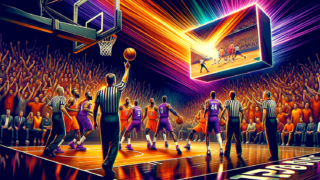
Delay of Game Warning in Basketball: Rules and Implications
Written by: Basketball Universe
Last updated:

Are you ready to dive into one of the lesser-known but critical aspects of the game we all love? In this blog post, we’ll delve into the world of the Delay of Game Warning – an often misunderstood and overlooked rule in basketball. Together, we’ll explore the intricacies of this regulation, the implications on the court, and its significance beyond the whistle. Let’s lace up our sneakers and embark on this exciting journey with the perfect combination of fun and professionalism as our companions, as we unravel the hidden layers of the Delay of Game Warning within this fast-paced and thrilling sport.
Delay of Game Warning in Basketball: Rules and Implications
The Delay of Game Warning in basketball occurs when a player or team intentionally disrupts the flow of the game, violating specific rules outlined by leagues such as the NBA or FIBA. Some common delay of game situations include touching the ball after scoring, excessive timeouts, or interfering with the inbounding process. Once a team receives a warning, subsequent violations may result in technical fouls, free throws for the opposing team, or even loss of possession. Coaches and players must be mindful of these rules, as their implications can significantly impact the outcome of the game.
Getting to Know the Rules: Diving into the Fundamentals of Delay of Game Warnings
Before we dive deeper into the topic, it’s essential to understand what constitutes a Delay of Game Warning in basketball. Familiarizing ourselves with these specific basketball rules and regulations helps clarify why they exist and how they impact gameplay.
Understanding League-Specific Regulations
Although the primary goal of basketball remains the same at all levels of the game, different leagues can have unique rules pertaining to the Delay of Game Warning. For example, the National Basketball Association (NBA) and the International Basketball Federation (FIBA) may have distinctive regulations that teams need to follow. To have a comprehensive understanding, we will be focusing on both NBA and FIBA rules throughout this blog post.
Delay of Game Warning: Common Scenarios
There are several instances where a team or player may receive a Delay of Game Warning. Some of the most common scenarios include:
- Touching the ball after scoring – A player is not allowed to touch the ball after it goes through the hoop, as this interferes with the other team’s inbounding process.
- Excessive timeouts – If a team requests more timeouts than permitted or takes longer than the allotted time, they may be penalized with a Delay of Game Warning.
- Illegal substitution – Bringing a player onto the court without proper signaling or at an inappropriate time may lead to a Delay of Game Warning.
- Blocking the inbounding process – Defenders must provide adequate space for an inbound pass, keeping at least a 3-feet distance from the player making the pass.
- Slow inbound – If the inbounding team takes more than five seconds to throw the ball back into play, they may receive a Delay of Game Warning.
Implications of Delay of Game Warnings: Power Play for the Opponents
Now that we’ve established the fundamental principles of Delay of Game Warnings in basketball, let’s examine the impact these rules have on gameplay. When a team or player receives a Delay of Game Warning, they risk giving their opponents a significant advantage. We’ll look at the penalties and consequences of these warnings and explore some strategic elements employed by teams to leverage these rules.
Penalties for Delay of Game Violations
Receiving a Delay of Game Warning comes with specific penalties, which vary depending on the league and whether the team or player received a previous warning. The common consequences include:
- First violation – For the first violation, the team or player usually receives a warning without any further penalty.
- Subsequent violations – If a team or player commits another Delay of Game violation after being warned, they may be assessed a technical foul. In this case, the opposing team receives one free throw, and their possession of the ball continues.
- Extreme cases – In rare instances, if the referee believes the offending team deliberately prolonged the delay, they may assess a technical foul without an initial warning.
Impact on Gameplay: Strategy and Positioning
Delay of Game Warnings can undoubtedly impact the momentum and flow of a match, as teams and players must adapt to avoid penalties. This can influence strategy and decision-making, forcing coaches and players to reassess their approach when facing potential violations.
Teams with a history of racking up Delay of Game Warnings might be targeted by opponents looking to exploit this weakness, baiting them into further violations. On the other hand, disciplined teams could use this rule to gain an edge over their opponents, forcing them to play at a quicker pace and make hurried decisions.
A Deeper Dive: Notable Examples and Moments in Basketball History
Many instances throughout basketball history have illustrated the impact of Delay of Game Warnings on a game’s outcome. By examining some of these significant moments, we can emphasize the importance of understanding and adhering to these crucial basketball rules.
A Costly Warning: The 2013 NBA Finals
In Game 6 of the 2013 NBA Finals between the Miami Heat and the San Antonio Spurs, a critical Delay of Game Warning proved pivotal in the match’s outcome. With less than a minute remaining on the clock, the Heat’s Chris Bosh touched the ball after a made basket, resulting in a warning. Only moments later, the Spurs’ Manu Ginobili committed a similar violation, earning the Heat a technical free throw that would ultimately contribute to their victory.
The Value of Discipline: The 2019 NBA Finals
During Game 2 of the 2019 NBA Finals, the Golden State Warriors demonstrated exceptional discipline and strategic understanding when facing the Toronto Raptors. With only a few seconds remaining and the Raptors preparing to inbound the ball, the Warriors carefully avoided interfering with the inbounding process despite tight defensive coverage. Their adherence to the Delay of Game rules allowed them to pressure the Raptors without incurring costly penalties, ultimately contributing to their narrow victory.
Cultivating the Mind of a Basketball Tactician
As we’ve discovered throughout this blog post, the Delay of Game Warning in basketball is no minor facet of the game. Its impact on gameplay and strategic decision-making can be significant and even game-changing. Basketball enthusiasts, aspiring coaches, and players alike can benefit tremendously from understanding the intricacies of this rule.
Basketball IQ: A Key Component for Success
Developing a high basketball IQ—defined as an intuitive understanding of the game—requires an in-depth knowledge of basketball rules, including Delay of Game Warnings. This understanding helps players and coaches make informed decisions during critical moments, maximizing their chances of success on the court. Players who comprehend these rules can avoid unnecessary violations and capitalize on opportunities presented by their opponents’ infractions.
Imparting the Knowledge: Coaching for Success
Coaches play a vital role in the development of a player’s understanding of Delay of Game Warnings and other essential basketball rules. By incorporating rule discussions into practice sessions and emphasizing the importance of disciplined play, coaches can nurture a team culture that prioritizes adherence to these regulations. This approach can yield tangible results on the court, positioning the team for success in close games where every possession matters.
Basketball Rules: An Ever-Evolving Landscape
In the world of basketball, rules and regulations are constantly evolving to maintain a fair and competitive environment for all participants. The Delay of Game Warning is just one example of how nuanced and intricate these rules can be, as well as how vital it is for players, coaches, and fans to stay informed and engaged with the sport’s regulatory framework.
Adjusting Your Play Style to Minimize Delay of Game Violations
Whether you are a coach or a player, understanding the Delay of Game Warning rules is critical in ensuring your team’s success on the court. By adjusting your play style and focusing on discipline, you can minimize the chances of receiving costly delay of game penalties. Here, we discuss some crucial tips to keep in mind that could help you and your team avoid these violations.
Effective Communication and Team Chemistry
One of the most critical aspects of minimizing the risk of Delay of Game Warnings is efficient communication between teammates. Ensure that everyone on the team is aware of game scenarios, foul situations, and the number of timeouts remaining. Developing strong team chemistry and trust contributes to a disciplined approach on the court and significantly reduces the chance of violations.
Following Inbounding Procedures Correctly
A considerable number of Delay of Game Warnings stem from inbounding-related violations, such as going over the five-second limit or interfering with the inbounder. Players both on offense and defense should familiarize themselves with inbounding rules and follow procedures correctly to avoid unnecessary penalties.
Timeout Management
Coaches play a significant role in managing their team’s timeouts to avoid delay of game penalties. Proper timeout management involves being aware of how many timeouts you have, when to use them strategically, and ensuring the team is ready to resume play within the allotted time.
Adapting to Referee Calls
Every referee interprets and enforces basketball rules differently to some degree. Recognizing a referee’s tendencies during a game and adjusting your team’s play accordingly can help minimize the risk of receiving Delay of Game Warnings.
Dealing with a Delay of Game Warning During a Match
If your team receives a Delay of Game Warning, it is important to address the situation and adapt accordingly. Here are a few suggestions on how to manage a warning during gameplay and ensure your team remains focused and disciplined.
Maintaining Composure and Focus
It’s crucial for teams to maintain their composure and focus in the face of a Delay of Game Warning. Panicking, arguing with the referees, or displaying negative emotions can adversely affect the team’s performance and increase the chances of further violations. Encourage teammates to remain calm and focused on the task at hand.
Learning from Mistakes
When a warning occurs, view it as an opportunity to learn and improve. Identify the reason for the violation and address it during the next available timeout or dead-ball situation. This proactive approach allows your team to make the necessary adjustments and reduces the likelihood of repeating mistakes.
Staying Engaged in the Game
Finally, remember the importance of staying engaged in the game, even after receiving a Delay of Game Warning. As we’ve seen from past examples, teams that can recover from such setbacks and maintain their focus can still achieve success on the court.
Frequently Asked Questions: Delay of Game Warning in Basketball
Now that we’ve explored the ins and outs of the Delay of Game Warning in basketball, let’s address some frequently asked questions on this topic. Whether you’re new to the sport or a seasoned fan, these answers will help enhance your understanding and appreciation of these critical basketball rules.
1. What is the main purpose of the Delay of Game Warning?
The primary purpose of the Delay of Game Warning is to maintain a smooth and continuous flow of the game, preventing a team or player from disrupting the gameplay intentionally.
2. What are the most common instances that lead to a Delay of Game Warning?
The most common scenarios leading to a Delay of Game Warning include touching the ball after scoring, excessive timeouts, illegal substitutions, blocking the inbounding process, and taking too long to inbound the ball.
3. How do the penalties for Delay of Game Warnings differ between first-time and repeat offenders?
For first-time offenders, the team or player usually receives a warning without further penalty. However, subsequent violations often result in technical fouls, granting the opposing team a free throw and continued possession of the ball.
4. Are Delay of Game Warning rules the same across all basketball leagues?
No, the rules regarding Delay of Game Warnings and their penalties can differ between leagues, such as the NBA and FIBA. It’s essential to familiarize yourself with the specific rules for each league you’re interested in.
5. What is a technical foul in the context of Delay of Game Warnings?
A technical foul is assessed after a team or player repeatedly violates the Delay of Game rules or deliberately prolongs the delay. The opposing team receives one free throw, and possession of the ball continues.
6. Is it possible for a referee to assess a technical foul without any prior warnings?
Though rare, a referee can assess a technical foul without an initial warning if they believe that the offending team intentionally prolonged the delay or if the violation is considered flagrant.
7. Can coaches receive Delay of Game Warnings?
Yes, coaches can receive Delay of Game Warnings for actions such as excessive timeouts, impeding the game’s flow, or unauthorized substitutions.
8. How can teams avoid Delay of Game Warnings?
Teams can avoid Delay of Game Warnings by adhering to inbounding rules, managing timeouts effectively, maintaining effective communication, and understanding referee calls. Disciplined play and a strategic approach can minimize the risk of receiving these warnings.
9. How does a Delay of Game Warning affect a team’s strategy during a match?
A Delay of Game Warning can have a significant impact on a team’s strategy, forcing coaches and players to reassess their approach when facing potential violations. Teams may attempt to exploit opponents with a history of violations, while disciplined teams can use the rules to gain an edge on the court.
10. How can coaches emphasize the importance of understanding Delay of Game Warnings to their players?
Coaches can emphasize the importance of Delay of Game Warnings by incorporating rule discussions into practice sessions, enforcing disciplined play, stressing the potential impact on gameplay, and fostering an environment of continuous learning and improvement.
Featured Posts
- No pillar pages found.





